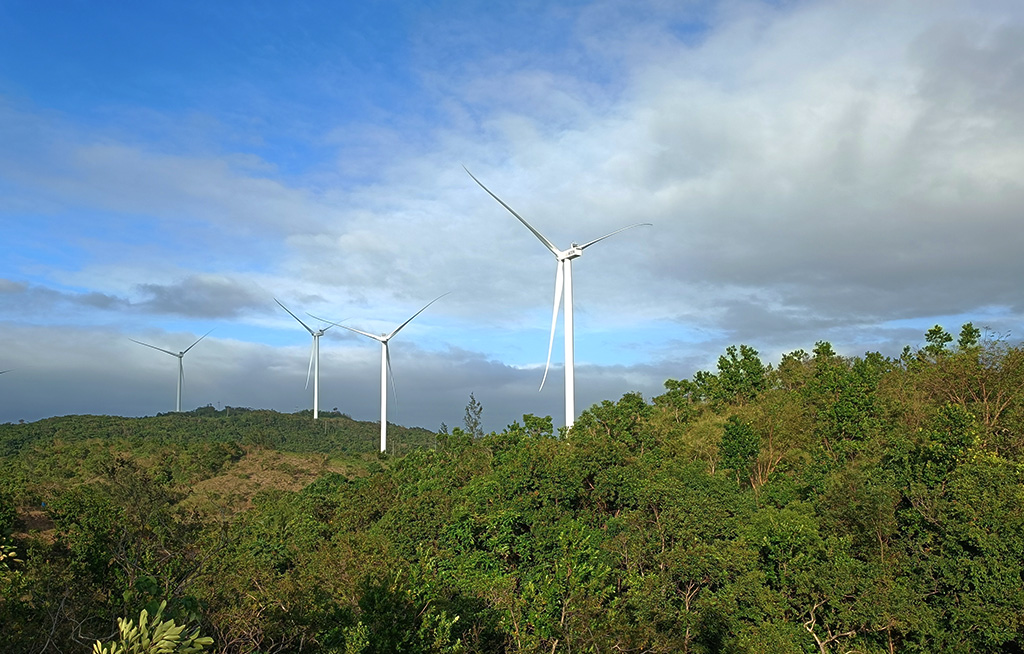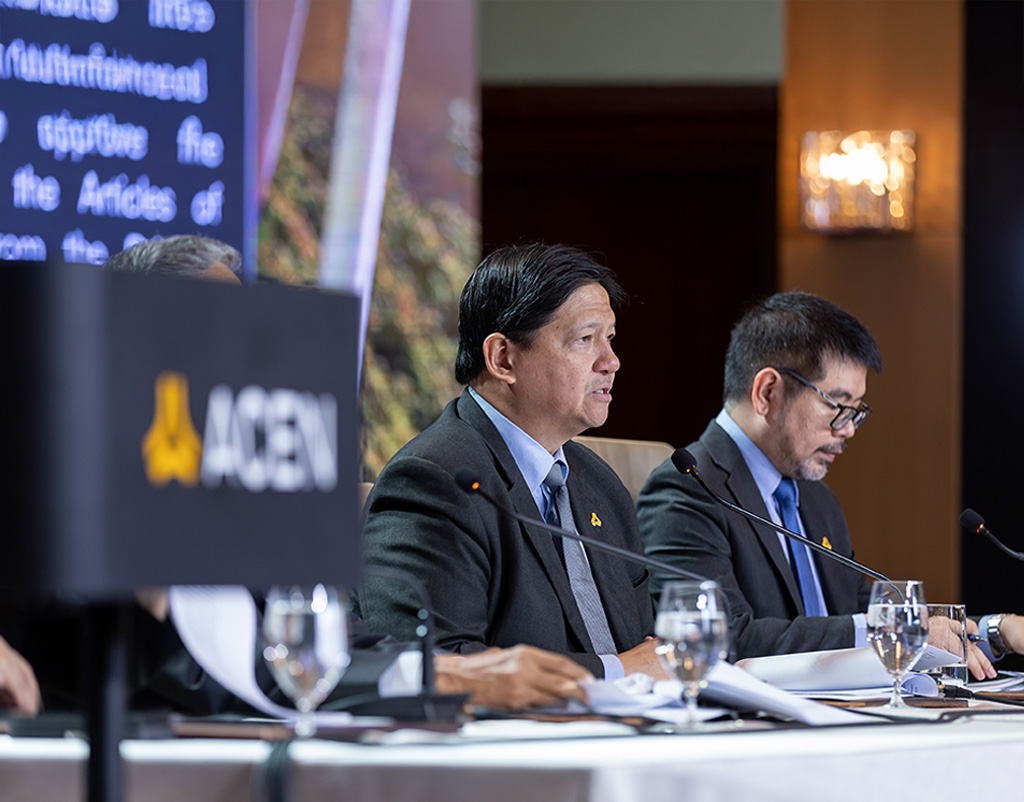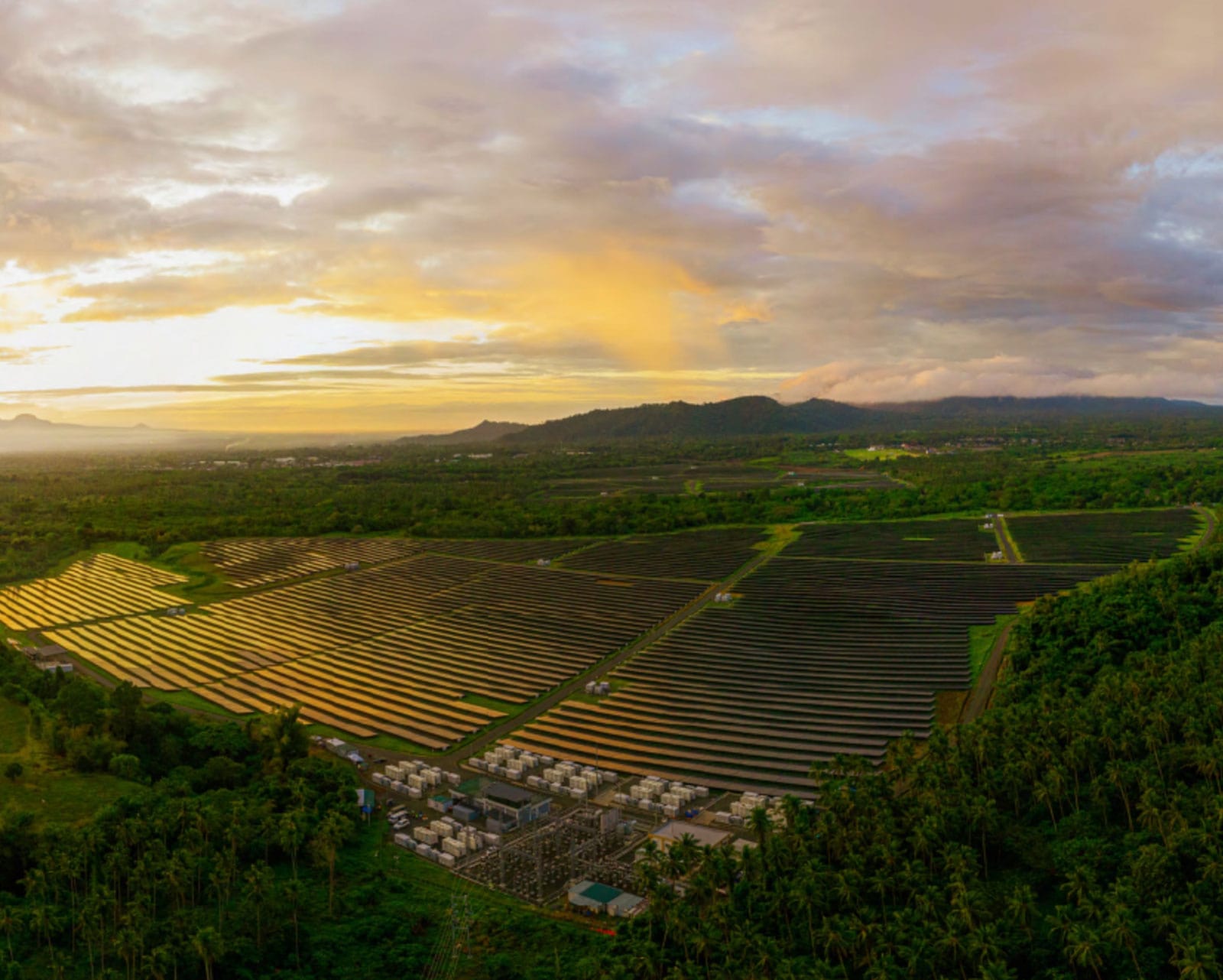We place ESG and sustainability
at the heart of what we do –
for future generations
Our strategic
sustainability approach
Sustainability is integral in ACEN’s business strategy. It is at the core of who we are and what we do. As one of the fastest growing renewable energy platforms in the Asia Pacific, we thrive on creating the most value for both society and our business.
As we grow our renewables portfolio, we continue to deliver on our climate commitments. The successful implementation of our Energy Transition Mechanism puts us in a position to play a leading role in the energy transition in the region.
We take pride in the partnerships we made in December 2023 with the Rockefeller Foundation’s Coal to Clean Credit Initiative and the Monetary Authority of Singapore to implement the world’s first coal-to-clean credit pilot project complement our early coal retirement for the 246 MW SLTEC coal plant by 2040.
The transition credit initiative will potentially accelerate the transition of coal to cleaner technology as early as 2030. If successful, this can be scaled up and replicated by other coal fired power plants not only in the Philippines but across the globe.
In embracing our role as a catalyst for sustainable change, we recognize that our journey is one that we cannot do alone. Our collaborative efforts, innovative spirit, and commitment to sustainability are the driving forces in making a positive impact on the environment and society.
Through the integration of our ESG principles into our operations, we are not only redefining the future of energy, but also laying the foundation for a more sustainable tomorrow, where energy not only powers our economies but also safeguards our planet for generations to come.
Profile
Policies
Reports
Leading the energy transition in the region
Our approach
We continue to expand our renewable energy portfolio while advancing our climate goals—ensuring access to clean, reliable, and affordable energy for all.
Our focus
We are on track to become a 100 percent renewable energy company by 2025.
As part of our just transition strategy, we are working toward the early retirement of the 246 MW SLTEC coal plant by 2040, which we successfully divested in 2022 through the Energy Transition Mechanism.
We also aim to achieve Net Zero greenhouse gas emissions by 2050.

Aspiring excellence in environmental management
Our approach
We are committed to protecting and conserving biodiversity, maintaining ecosystem services and responsibly managing natural resources throughout the lifecycle of our power plants.
Our focus
We work to safeguard natural habitats and biodiversity as part of our broader efforts to address climate change. In developing our projects, we continue to apply the mitigation hierarchy and aim for No Net Loss of biodiversity.


Investing in our people
Our approach
Our energy transition is a shared journey with our workforce—anchored on a Just Transition that leaves no one behind.
Our focus
We develop programs and provide benefits that support the growth and well-being of our team members.
We continue to prioritize the health and safety of our employees, customers, suppliers and the communities we serve.
Creating inclusive communities
Our approach
We develop renewable energy projects that generate meaningful impact and tangible benefits for the communities where we operate.
Our focus
We aim to create opportunities that uplift our host communities—through job creation, sustainable livelihoods and improved access to basic services and human needs.

Integrating sustainability into our business operations
Our approach
We continue to grow our renewables portfolio while delivering our climate ambitions that will provide access to clean, reliable and affordable energy.
Our focus
We proactively work to enhance our ESG reporting in order to deliver on our sustainability ambitions.
We continue to collaborate with all our stakeholders and place their interests at the core of our operations.
We align our processes in all the jurisdictions where we operate and ensure ESG management practices.
We strive for leadership diversity and inclusion to foster a culture of excellence.
We align our disclosures and policies with the difference ESG frameworks and data providers.

Sustainability highlights
Environment
1 million trees planted
A year ahead of our 2025 target
As of end-2024, we have achieved our ambition, planting 1,017,103 trees across 43 sites in the countries where we operate.
Net Zero progress
2030 target for scope 1 emissions achieved
We surpassed our 2030 target of a 73.6 percent reduction in scope 1 emissions per MWh from our own energy generation activities, achieving an 81 percent decrease compared to our 2021 baseline.
Pioneering energy transition
In August, we signed a Memorandum of Understanding (MOU) with GenZero and Keppel Ltd. to jointly explore the origination and utilization of Transition Credits to accelerate the retirement of the SLTEC coal plant and replace it with a clean energy dispatch facility.
Resource efficiency
8,900 kg of plastics
diverted from landfill
Social
Employer award
Best Companies to Work for in Asia
We were recognized as one of the Best Companies to Work for in the Philippines, honoring our strong employee engagement and exceptional workplace culture.
Our employees
1,194
across the ACEN group
We continue to foster a workplace where employees are empowered to drive our growth and expansion.
45%
women
vs 40% in 2023
43,176
safety training hours
Upholding the highest health and safety standards, we doubled our safety training hours compared to 2023.
Our communities
~95%
hired from local communities
during construction
Community investments
~P222
million
Governance
4 Golden Arrows recognition
For the second consecutive year, we were awarded with 4 Golden Arrows by the Institute of Corporate Directors (ICD) at the 2024 ASEAN Corporate Governance Scorecard (ACGS) Golden Arrow Awards, signifying alignment with international corporate governance standards and practices.

ACEN Speak Up Safely
Demonstrating our unwavering commitment to conduct business with the highest ethical standards, we launched the ACEN Speak Up Safely, an independent and confidential whistleblowing platform managed by a third-party.
Diversity in leadership
38%
women
ESG RATINGS
Progress compared to baseline score
CDP: Climate Change score
Sustainalytics: ACEN Gamered a lower ESG risk rating from high risk to medium risk
Our materiality process
To determine economic, environmental, social and governance issues that are important to ACEN and our stakeholders, we conducted a series of materiality exercises in collaboration with an external consultant and business unit heads. identifying topics that are important to ACEN both financially and from an external impact perspective.
Our material ESG issues were updated to reflect our engagements with investors, rating institutions, and other stakeholder concerns regarding ESG. This was supplemented by research activities on the latest developments around sustainability reporting frameworks and industry-specific sustainability issues. Roadshows were also conducted with our leadership team and the board-level Sustainability Committee to validate our material ESG issues and identify strategic action plans around key ESG issues moving forward.
We conduct the materiality process every 1-2 years to ensure that material ESG topics and our ESG strategy are continuously updated to ensure relevance to our stakeholders.
ACEN’s material issues
Environment
Circular economy
Energy efficiency & carbon reduction
Climate risks and opportunities
Biodiversity
Air pollution
Waste management
Environmental policy & certifications
Social
Human rights
Occupational health and safety
Supply chain sustainability
Human capital management
Local communities
Customers
Economic/Governance
Energy infrastructure
Business ethics & good governance
Sustainable finance
Innovation, digitalization, cybersecurity
Our ESG Policy

Paving the way to integrate sustainability in the way we work and influence our decision-making on strategy, capital allocation, operations, governance, and culture is our ESG Policy, with the aim to deliver long-term value for all our stakeholders.
As part of our sustainability commitment, we implement the Environmental and Social Management System (ESMS) to manage E&S risks and impacts throughout the life cycle of our projects. Through the ESMS, we are able to identify and assess E&S risks to develop appropriate action plans and mitigation measures.
Our Environment and Social Management System Process
PHASE 1:
ASSESS E&S RISKS
Step 1. General E&S Risk Identification
Step 2. Risk Prioritization
Step 3. Stakehoider
Engagement and Mapping
Step 4. Emergency Scenarios Assessment
PHASE 2:
MANAGE E&S RISKS
Step 5. Formulate E&S Action Plan for Priority Risks
Step 6. Formulate Stakeholder Engagement Plan
Step 7. Develop Stakeholder Communication Platform
Step 8. Formulate Emergency Preparedness Plans (as necessary)
PHASE 3:
APPROVAL OF E&S ACTION PLANS
Step 9. Secure approval of E&S Action Plans
Step 10. Issue Notice to Proceed
PHASE 4:
IMPLEMENTATION
MONITORING & REPORTING
Step 11. Ensure compliance with national regulatory requirements and internal monitoring of E&S Action Plan implementation
Step 12. Conduct a semi-annual review on the progress and compliance of all E&S Action Plans and Stakeholder Engagement Plans

